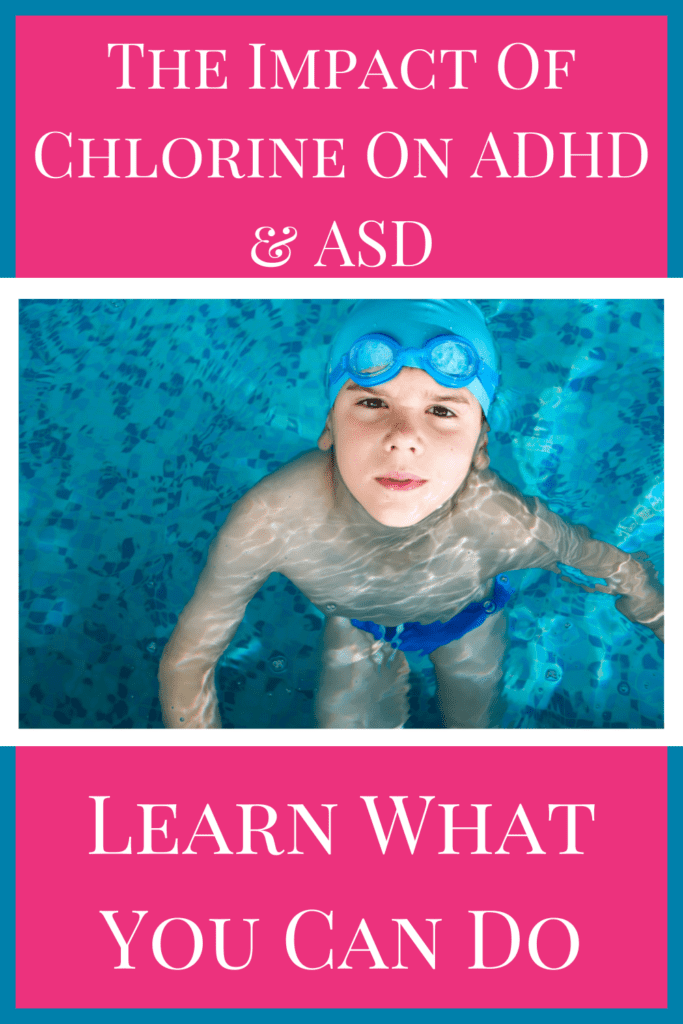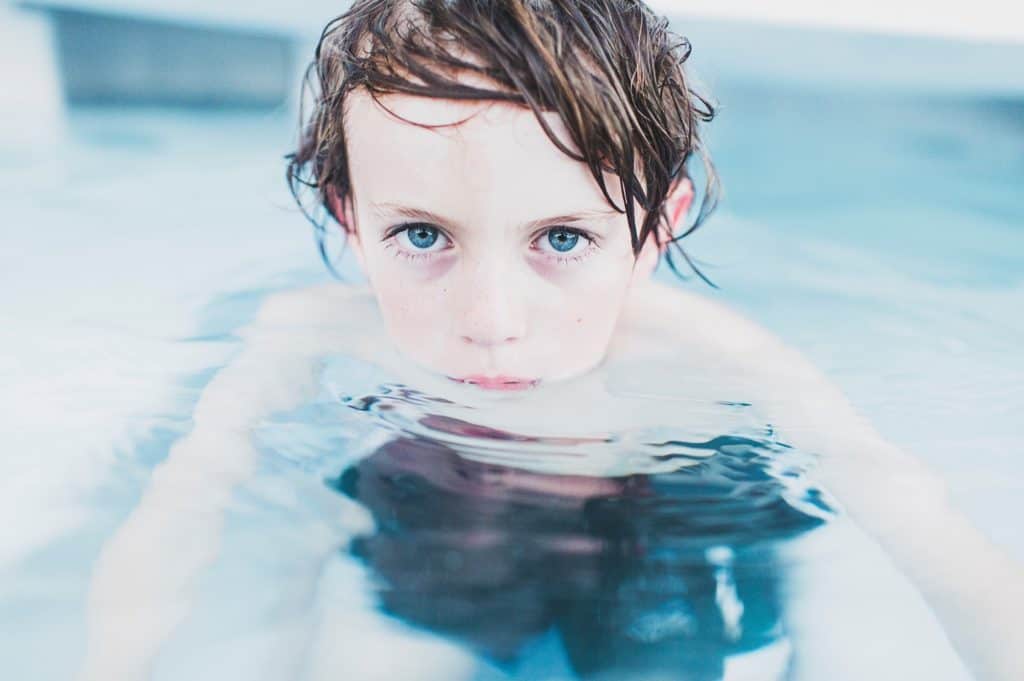Up until this summer I didn’t mention chlorine to my clients because of all the toxins that are of concern chlorine was least on my radar. The only reason I knew how chlorine can impact behaviour, mood and brain function is because of my daughter.
Chlorine Effects – It’s Personal
When we finally learned my daughter had PANS (an autoimmune disorder in which her immune system was attacking her brain), I did everything I could to heal her gut and limit chemical exposure. By chance, I came across an article how sensitive PANS/PANDAS children were to chlorine and how it can set them back into a full-fledged flare – what every PANS parent desperately tries to avoid.
My daughter’s increased anxiety, sensory overwhelm, irritability and even tics all became markedly pronounced within hours of being in the pool. I couldn’t imagine telling her she couldn’t swim anymore – especially when she loved it so much. I didn’t – I’ll tell you more about what I did in a moment.
I didn’t realise how much even ADHD and ASD kids were impacted by chlorine. I thought my daughter’s case was unique because of the immune factor. Then summer arrived and clients told me they felt like they were doing everything right and their child was still regressing. After some digging, the common denominator in most of these instances was swimming in chlorinated pools.
It’s Not the End of Swimming
I’m not about to ruin your child’s summer fun – or yours. I promise. No one is asking you to get rid of your pool. BUT if you have a child with ADHD, ASD, PANS/PANDAS or any other neurodevelopment disorder, we need to talk about chlorine.
Both how it affects your child’s behaviour, their immune system and their liver.
I know that when Moms start learning about all their child’s triggers it can be overwhelming! It can feel like compared to the other kids, you’re requiring your child to live in a bubble when it comes to avoiding toxic exposure.
Many of us are aware of the harmful effects of chlorine in our drinking water, (especially mother warriors of ASD and PANS children) but we don’t think much of bathing in chlorine because most of aren’t aware that our skin absorbs 50% of what we put on our skin – and for many people that percentage is even higher.
The Research on Chlorine
If you think I am being paranoid, consider this.
Both the CDC and the American Society of Pediatrics acknowledge the health hazards of chlorine and chloramine and that children with ADHD, autism, and other health issues will experience more intense effects from chlorine exposure. The American Academy of Pediatrics’ study on the effects of chlorine on nearly 1000 children found that chlorine impacted the immune system of children, increasing their symptoms of everything from allergies to asthma to behaviour.
The Oxford Journal of Medicine also warns that drinking chlorinated water is not the only risk factor for an increased risk of cancer but swimming in chlorinated pools as well.
The recognition of the neurotoxic effects of fluoride has made headlines by multiple sources such as Harvard University and The Lancet, the world’s oldest and most prestigious medical journals- and it has been banned from most European and Asian countries as well as many cities in the US and Canada. Yet, chlorine comes in close behind fluoride and is simply not getting the attention it needs.
The Problem with Chlorine & ASD, ADHD and PANS Children
Before I explain how you can lessen the impact of chlorine on your child’s system let me briefly explain why it’s a problem. The issue is that many ASD, ADHD and PANS children have PST (phenol sulfur-transferase) issues. Among many toxins, chlorine can seriously aggravate these problems which results in a worsening of behavior and further immune dysfunction.
Chlorine is a toxin that impacts every organ system but wreaks the most havoc on the immune system and liver. As if the skin being a sponge isn’t problem enough, the chlorine gas that is released from the water, enters the lungs all too easily and then passes into the bloodstream. After only 40 minutes of swimming, there is an increase in markers for DNA damage.
The most common complaints about chlorine are fatigue, exhaustion (swimming is much less exhausting in lakes, rivers and the ocean because of the absence of chlorine). Other symptoms that are reported are rashes, asthma, defiance, aggression, irritability, sensory overload, hyperactivity, tics, increased in OCD behaviour, as well as respiratory problems and coughing.
So What Do You Do?
Okay, I’m not going to sugar coat anything here. Limiting your child’s exposure to chlorine is ideal.
Swimming at beaches is preferable, and there are also so many other types of pools that no longer require chlorine.
I also try to limit the amount of time my daughter spends in the pool without ruining her life. So instead of swimming everyday in a pool, we try to mix it up between beaches and pools.
Below are some ways to reduce your child’s chlorine exposure and how to neutralize the effects after they have been swimming.
1. Taurine – This is my number one approach. This amino acid helps to produce GABA, a neurotransmitter that is often low in these children to begin with. GABA helps to promote feelings of calm and relaxation and regulates the sensory systems. Taurine helps to bind and detox chlorine and should stay in your child’s system for 48 hours. This works best when given thirty minutes before swimming.
2. Shower Before – Saturate your child’s pores with water by having them shower beforehand.
3. Create a Barrier – Apply coconut oil or all-natural sunscreen before entering the pool. The oil acts as a barrier and further helps to prevent the absorption of chlorine.
4. Shower After – Showering after swimming can help remove any chlorine off your child’s skin to prevent further absorption.
5. Epsom Salt Spray – Spray your child with an Epsom salts or magnesium sulfate spray OR use magnesium sulfate cream on their body. Some people mix this with their all-natural, organic sunscreen.
6. Vitamin C – Vitamin C helps to neutralize and undo chlorine’s damage. Use a high-quality vitamin C to detox the body and feel free to add some vitamin C to the magnesium spray bottle.
7. Magnesium – Supplementing with magnesium can ensure your child’s magnesium levels are optimal. Magnesium gets rapidly depleted in the body upon chlorine exposure.
8. Iodine – Both chlorine, fluoride and bromine block iodine absorption. Many children with ASD and ADHD have thyroid problems that often go undiagnosed because they are not serious enough to show up on standard blood tests. We all know that iodine is necessary to support the thyroid, as well proper immune function.
Supplement with iodine if necessary. I prefer to use a high-quality Kelp supplement, or I drop two drops of Lugol’s iodine on my daughter’s wrists each night. This method is great because you will know when you are no longer deficient because there will still be an iodine stain the next day if your body no longer needs it.
9. Detox Baths – Baths with Epsom salts, baking soda and peroxide can also help to increase detoxification. Baths should be a minimum of 15 minutes.
10. Mop up the Mess – Activated Charcoal is phenomenal for absorbing toxins. Taking charcoal capsules after swimming can help to absorb chlorine so it doesn’t wreak any more havoc. Keep in mind that activated charcoal grabs anything so dose it away from any medication.
11. Protect the Gut Flora – Increase probiotics and enzymes as chlorine kills bacteria–good and bad! Healthy gut bacteria have many purposes – detoxing is one of many.
The above list can seem like you are prepping your child for space, but keep in mind many parents don’t have to do all of these steps. Many parents only need to do Taurine before swimming and a shower or detox bath afterwards with some supplements to help mitigate the effects of chlorine.
Toxicity is a major factor with children with learning and behavioural issues. Detoxification is crucial. Want to know what else could be triggering your child and how you can help your child achieve their optimal health. Schedule a free Better Brain Session with me by emailing me.


